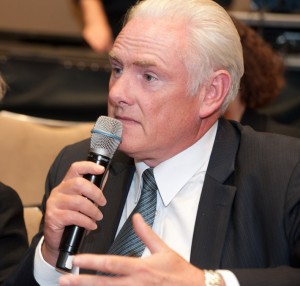Global conference: velocity versus efficiency in spare parts
Consumers and customers are becoming an increasingly demanding bunch. Long gone are the days of customers waiting weeks for products – including service parts or aftermarket accessories for their vehicles. After all, if consumers can have next day delivery of anything from a pair of socks to a television from Amazon, why do they have to wait for service parts, which would mean potentially being without their vehicle?

Speaking at the Automotive Logistics Global conference in Detroit, industry consultant Bruce Arlinghaus said that e-commerce companies such as Amazon have contributed to a fundamental shift in expectations when it came to waiting for products.
“Manufacturing drove customer behaviour for a long time, and the Amazons took over the marketplace,” he said. “The next big market wave is customer satisfaction. If you can keep them happy and they don’t have to wait, that’s important across all industries."
However, while delivery speed is critical to automotive, the industry’s complexity also means that the balance between safety, quality and cost is more finely balanced than it might be for socks or shoes. “Certainty above velocity is the key observation I have,” observed Nick Beard, industry director for automotive at TNT. “While consumers expect certainty, this doesn’t necessarily have to be the same day, like the Amazon model.”
As a result, carmakers and logistics providers are looking aggressively at ways to deliver fast service but also reduce cost and waste, even if it might not always mean the shortest possible lead time, according to Steven Jernigan, senior manager SAM, Americas Logistics at Nissan. “The network is changing. We are trying to improve delivery to dealerships, but will it continue in the same direction? We have to figure out how to be faster, but also more efficient, and will have to approach it differently.”
“Trailers often run 40% empty,” Beard added. “Think about how to slow down the supply chain, which would be more environmentally friendly, especially in Europe, where regulations are coming on really rapidly, and getting hold of drivers is a big issue.”
Sharing the benefits
One way that manufacturers are finding ways to improve their networks and improve empty trailer space is through shared logistics services. While such services for spare parts and aftersales between OEMs may not be ‘common’ yet, competitive OEMs working together is becoming more of a norm. Jernigan said that a shared service could help to cut costs, reduce the carbon footprint, improve quality, and customer satisfaction, he said.
Steve Kovacs, general manager at Schneider Logistics, said that there is already more integration than people realise. “Since the 2009 recession, every OEM we work with has been open to shared service,” he revealed. “It’s very difficult, but people are open to it. You have to know where it makes sense, and where you need it is remote areas.”
Thor Oxnard, national manager of logistics planning for Toyota Motor Sales, said the carmaker is actively looking for shared services in spare parts. The OEM can fill 80-90% of trailers, but for some dealers in the US, shared services would make sense. Oxnard said that the carmaker has a partnership with BMW in the northeast, which was arranged by its logistics provider. He added that LSPs often arrange such deals rather than OEMs.
However, while the shared model does have its advantages, it can raise issues, particularly around unexpected delays or transport problems. Mark Kunar, president, automotive and engineering and manufacturing at Exel said, “The shared model is difficult because if one OEM delivers parts late, what do you do then? No one from Toyota wants to have late parts because of another OEM.”

No less competitive
While OEMs were open to shared services, and velocity might not always count for everything, executives also didn’t want to let go of their competitive advantages, or indeed lessen the competition between manufacturers or logistics providers. Nissan’s Jernigan maintained that such competition is healthy, and the industry needs to learn how to deliver at a competitive cost, understand inventory at dealerships, and provide better service.
Robert Jones, senior director at Neovia Logistics, also stressed that providers could improve service. “I feel as an industry, we can do a better job,” he said. “We need to think that we’re not selling parts, but a service, and deliver a pleasant product experience. The fact we have to get a part there to orchestrate is the second step. It’s customer focused now.”
Click here for an executive summary of key themes of the Automotive Logistics Global 2014 conference.
Click here to see video recordings of select sessions from the conference.





